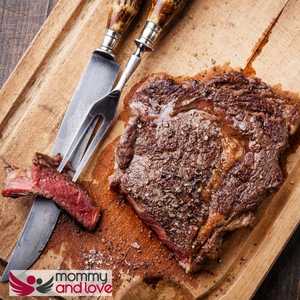As you know, rare steak contains lots of healthy nutrients that are very good for both your baby’s and your own health. However, there are some guidelines to be followed – particularly if your child is under 4 months.
It is not recommended to eat rare steak when breastfeeding if the infant is below four months old because he or she is not able to convert the parent’s nutrient intake into a useable form.
Also, eating rare steak poses a slight risk of exposure to toxoplasmosis – a parasitic disease that can be very harmful for an infant up to 12 months old.
However, if your child is over 4 months old and you wish to eat rare steak, go ahead and enjoy. The risk of toxoplasmosis is significantly lower for your baby since his or her digestive system has matured enough to safely process the meat.
As you can see, eating rare steak while breastfeeding is safe unless it’s risky for some reason (for example, if you’re a vegetarian and don’t eat any kind of meat).
What are the benefits of eating steak while breastfeeding?

Steak is high in iron and protein, both of which are essential for the healthy development of a baby.
The next time you go shopping, don’t hesitate to pick up a sizzling steak from the store instead of some bland veggies.
To make sure your next meal turns out amazing, consider buying a cast-iron skillet tocook your steak in.
After you are finished cooking, try sprinkling some sea salt on the meat for extra flavor.
Hamburgers are also a healthy choice while breastfeeding – just consider what ingredients are included with the patty to make sure it’s safe for your child.
When buying beef patties for yourself, keep inmind that ground beef is not safe for your child, since it contains lots of filler.
Is eating rare meat safe while breastfeeding?
Eating rare steak is perfectly safe for both you and your baby as long as you follow the right guidelines. Just remember to keep in mind that steak can contain harmful pathogens that are unsafe for an infant.
Always make sure the meat is cooked through (especially if you’re using ground beef) to reduce your baby’s risk of exposure to toxoplasmosis, an illness that can be life-threatening for young infants.
How much steak can I eat when breastfeeding?

It is safe to eat a moderate amount of steak when breastfeeding. Overindulging will not provide any additional benefits (in fact, it might make your child develop an aversion to meat).
You can always try eating some lean ground beef to see how much steak you actually needto feel full.
Does steak affect breast milk?
Eating steak should not have any negative effects on your milk supply.
How long does it take for steak to get into breast milk?
It will take up to 3 hours before you notice any changes in yourbreast milk after you’ve eaten steak.
Does breastfeeding make meat taste different?
When breastfeeding, your sense of smell is heightened – allowing you to enjoy the full flavor of any meal you are consuming. If something tastes off, it could be because the meat has gone bad.
Tell me the best meat for a breastfeeding diet
The best meat for breastfeeding women is lean ground beef, which has a high amount of protein and iron – both essential nutrients that are crucial for your child’s development.
Highly processed foods are generally not nutritious foods and a breastfeeding baby needs a varied diet from their nursing moms. Deli meat, cold cuts, hot dogs and other foods are fine but in moderation. Eating fish is fine, again in moderation.
There are certain foods you should avoid while breastfeeding but generally the rule is have your food preferences but in moderation. Food sensitivities are less likely if your baby if they have been introduced to a wide range of food groups and the health benefits on the baby’s system that comes with breast feeding generally outweighs the risks.
Whilst you can have caffeine, your caffeine intake and even your cow’s milk intake should be limited. You can have the occasional glass of wine, but any more alcohol should be avoided, like energy drinks.
Can you get food poisoning from rare steak?
It is possible to get food poisoning from rare steak. Steak can contain harmful pathogens that are unsuitable for an infant.
When cooking meat of any kind, make sure it’s thoroughly cooked to reduce the risk of exposure to toxoplasmosis, a parasitic disease that can cause severe harm to your child up until he or she reaches 1.
Unlike in pregnancy, a breastfeeding diet can include raw meat, spicy foods, you can even eat soft cheeses and eat smoked salmon. Breastfeeding moms should however eat all of these as part of a healthy diet. Whilst you can eat junk food, its best for your breastfed baby to eat a balanced diet. Lean meat is better than rare beef or undercooked meat. Spicy food is fine, and you can eat cruciferous veggies but you may notice baby get fussy afterwards.
How much beef should I eat while breastfeeding?
It’s safe to eat up to 2 oz of beef per day when breastfeeding. Never try to consumemore than that, especially since this food is high in fat and calories.
1oz of beef contains around 95 calories.
Will steak boost breast milk production or milk supply?
Although steak does contain some essential nutrients for lactation (such as iron and protein), you should not expect it to significantly boost your breast milk production. There are other foods and herbal supplements and herbal teas which might have a greater impact on your milk supply. Try coconut water or dried fruit or speak to your lactaction consultant or healthcare provider if you are worried about your milk supply.
Take Away On Can I eat medium steak while breastfeeding?
Eating a medium steak is perfectly safe while breastfeeding. If you think that the meat tastes strange or doesn’t smell right, be sure to discard it and purchase a fresh batch instead. Breastfed babies need to be introduced to a wide range of foods, but the rule is everything in moderation and nothing in large quantities.
Enjoy that steak mama!

This article was written by Sandra Baker – full time writer and the mother of four amazing kids (including twins!)
She’s also a breastfeeding counselor and has spent years helping new parents learn how to care for their children. When she’s not writing or caring for her children, Sandra likes to spend time reading and taking walks with her husband.




